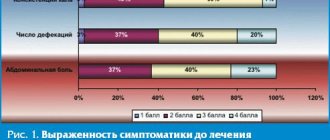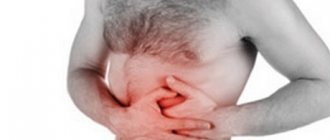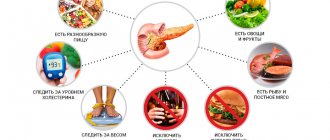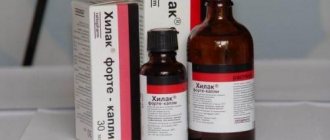Types of pancreatitis
In acute form of pancreatitis
a person experiences pain in the upper abdomen. Usually the pancreas hurts after fatty foods and alcohol. Pain in acute pancreatitis can be barely noticeable or severe (sometimes even radiating to the shoulder blade or chest). During an attack of acute pancreatitis, there may be nausea, vomiting, diarrhea, or constipation. The skin may turn yellow due to poor bile flow.
For chronic pancreatitis
pain in the upper abdomen, radiates to the back, left side of the chest, and lower abdomen. The pancreas hurts after fatty foods, alcohol or frequent stress. With chronic pancreatitis, nausea (sometimes vomiting), bloating, loss of appetite, and problems with stool (diarrhea or constipation) appear.
In chronic pancreatitis, periods of exacerbation alternate with periods of remission. If pancreatitis is not treated, exacerbations occur more often, intestinal disorders are observed, food ceases to be digested normally, and the person loses weight sharply.
Often, with chronic pancreatitis, various complications develop: bleeding in the stomach, abscesses and cysts, liver damage, enterocolitis, diabetes mellitus and even oncology. That is why, at the slightest problem with the pancreas, you need to consult a doctor as soon as possible.
The functioning of the pancreas is normal
Pain as a symptom of pancreatic dysfunction
The main task of the pancreas is to produce digestive enzymes called enzymes and transport them to the duodenum, where the enzymes carry out the process of digesting proteins, fats and carbohydrates from food.
At the same time, the pancreas is an endocrine gland of the body, that is, it performs an endocrine function. The islets of Langerans are responsible for this, the beta cells of which produce insulin, and the alpha cells produce glucagon; they normalize blood sugar levels.
Insulin eliminates hyperglycemia by lowering blood sugar, and glucagon acts in hypoglycemia by increasing blood sugar. With insufficient amounts of insulin, carbohydrate, fat and protein metabolism is disrupted, due to the fact that glucose cannot enter the cells of the body's tissues.
Pancreatic hormones help supply energy material in the form of broken down fatty acids to the tissues of the kidneys, liver, and heart muscle. If the endocrine function of the gland is disrupted, there is a high risk of diabetes mellitus and disturbances in the body’s energy metabolism.
Why does pancreatitis develop?
Pancreatitis begins when the tissue of the pancreas becomes inflamed. Causes of pancreatitis
- such:
- smoking and alcoholism;
- surgical operations and abdominal injuries;
- prolonged and uncontrolled use of certain medications (hormones, antibiotics, corticosteroids, some diuretics);
- food or chemical poisoning;
- heredity;
- poor nutrition (abundance of fatty and spicy foods, rare meals).
Symptoms of pancreatitis
Symptoms of pancreatitis differ between acute and chronic forms.
Acute pancreatitis
has the following symptoms:
- Cutting, dull, constant and intense pain.
- Increased body temperature and pressure surges (can be both high and low). The reason is the rapid development of inflammation.
- The skin of the face becomes pale or yellowish.
- There is often nausea and vomiting, dry mouth, and a white coating on the tongue. With such symptoms, you need to fast so as not to worsen the situation.
- With pancreatitis, both diarrhea and constipation are possible. With diarrhea, the stool is often foamy, with particles of undigested food, and a foul odor. With constipation, the abdominal muscles are tense and bloating is felt (during an attack of pancreatitis, the intestines and stomach stop contracting).
- Shortness of breath, which occurs from dehydration when a person vomits frequently.
Chronic pancreatitis
has the following symptoms:
- The pain in the abdomen is either girdle, or in one point, but radiates to the back. The pancreas usually hurts immediately after eating.
- Poisoning of the body (intoxication) is expressed in general weakness, poor appetite, accelerated heartbeat, increased temperature, and decreased blood pressure.
- Endocrine problems – diabetes mellitus, risk of hypoglycemia and ketoacidosis. Red spots may appear on the skin of the abdomen, chest and back (if you press on them, they do not disappear).
If pancreatitis is not treated, a person begins to lose weight, develops anemia, vitamin deficiency, brittle hair and nails, and constant fatigue.
Diagnosis of acute pancreatitis
Acute pancreatitis remains the most severe disease, the incidence of which varies. The authors of the work “Acute pancreatitis. Pathophysiology and treatment" (Kharkov, 2002) provide the following data: "Patients with acute pancreatitis make up 10–12% of the total number of surgical patients. The incidence is steadily increasing from year to year (according to world statistics, from 200 to 800 patients per 1 million people per year). In 15–20% of cases, the development of acute pancreatitis is destructive, and mortality in the systemic toxic phase varies between 20–45%. Infectious complications in 80% of cases lead to the death of patients with destructive pancreatitis, and currently infection is considered the main cause of death from pancreatic necrosis.”
The cause of the development of acute pancreatitis can be any of the following factors. The basis of the action of each of them is the effect on the pancreas with a subsequent increase in its function.
- Disturbances in the outflow of pancreatic juice in cholelithiasis, strictures and inflammation of the major duodenal papilla.
- Trauma (including operating room).
- Nutritional factor (intake of excess food, extractives, meat, fats, especially of animal origin, alcoholic beverages).
- Acute circulatory disturbance in the pancreas: vascular thrombosis, compression.
- Intoxication, severe allergic reaction.
- Endocrine disorders arising from hyperparathyroidism, pregnancy, long-term treatment with corticosteroid hormones, congenital or acquired disorders of fat metabolism (severe hyperlipemia).
- Infectious and viral diseases (mumps, viral hepatitis).
Prognosis of acute pancreatitis
The overall mortality rate is 3–7%, the mortality rate for pancreatic necrosis is 20–50%, and for pancreatic necrosis that requires surgical treatment, it is from 30 to 85%.
How does acute pancreatitis develop?
In the pathogenesis of acute pancreatitis, there are two main phases of the disease. The first phase of the disease is caused by the formation of a systemic inflammatory reaction during the first day from the onset of the disease, when autolysis, necrobiosis and necrosis of the pancreas and retroperitoneal tissue are abacterial in nature. During these periods of the disease, depending on the severity of pathomorphological disorders, the formation of interstitial (edematous) pancreatitis or sterile pancreatic necrosis is possible.
With the progression of the pathological process in the 2-3rd week of the disease, there is a natural transition to the second phase of acute pancreatitis, which is characterized by the development of late post-necrotic complications associated with infection of necrotic tissues. Under these conditions, inflammatory mediators are released. The basis for the development of septic complications is infection with the release of toxins.
It has been established that with the prevalence of necrotic lesions, a high degree of infection occurs. The addition of infection in conditions of an extensive necrotic process is accompanied by the development of widespread infected pancreatic necrosis, and with limited necrosis, an abscess is formed.
As the disease develops, a number of processes occur, knowledge of which is the basis for planning the choice of type of therapeutic nutrition.
Scheme 2. Stages of development of acute pancreatitis
Pathophysiology of the development of acute pancreatitis:
Swelling of the pancreas and hemorrhages into the gland tissue, retroperitoneal tissue:
- systemic reaction of the vessels of the pancreas and other organs, first in the form of narrowing, then expansion;
- increased permeability of the vascular wall;
- slowing down blood flow due to the release of the liquid part of the blood and blood cells into the surrounding tissues from the lumen of the vessels.
Disorders of local circulation contribute to thrombus formation. In conditions of vascular thrombosis, as a result of disruption of tissue metabolism and the direct action of enzymes on cells, foci of necrosis are formed in the pancreatic parenchyma. Lipases are released from destroyed cells, under the influence of which fat necrosis of the pancreas, omentum, retroperitoneal tissue, etc. occurs.
General changes in the body are caused initially by enzymatic and then tissue (from foci of necrosis) intoxication. Isolation of enzymes from damaged gland cells, under the influence of which trypsinogen turns into trypsin, which in turn activates kallikrein. The latter, acting on kinogen, forms a highly active peptide kallidin, which quickly turns into bradykinin. Under the influence of trypsin, histamine and serotonin are released from the gland cells, and the Hageman factor and plasminogen are activated in the blood. Through the lymphatic and circulatory routes, pancreatic enzymes enter the general bloodstream - a syndrome of systemic “evasion” of pancreatic enzymes is observed.
The syndrome of systemic “evasion” of pancreatic enzymes has laboratory confirmation - the study of amylase and lipase in blood serum and urine. It is the level of these enzymes that is a criterion for the activity of acute pancreatitis and a criterion for abstinence from eating foods per os.
Exposure to the vascular bed of vasoactive substances leads to circulatory disorders at all levels: tissue, organ and systemic, which is the cause of dystrophic, necrobiotic and necrotic changes. Exudation into tissues and cavities causes severe disturbances in water-electrolyte, carbohydrate, protein and fat metabolism.
Pathological changes in the pancreas.
With pancreatic necrosis, changes in pancreatic tissue primarily depend on the duration of the process. Swelling and necrosis of the pancreas and retroperitoneal tissue usually develop in the coming hours of the disease.
1–3 days
In the initial stage, the gland is significantly enlarged, compacted, has a dark red color on the section, wear of the lobular structure is noted, but there are no pronounced necrotic changes. Scattered small yellow foci of fat necrosis are found only under the parietal peritoneum covering the pancreas, in the lesser and greater omentum, renal capsule and intestinal mesentery. A serous or serous-hemorrhagic effusion is detected in the peritoneal cavity.
If the above processes do not undergo reverse development, i.e., the treatment is ineffective, the process moves into the next phase: systemic reactions are formed that trigger the development of the pathological process.
3–7 days
Necrosis of pancreatic tissue develops: diffuse-focal, large-focal, subtotal or total. The outcome of such pancreatic necrosis is diffuse focal fibrosis and lipomatosis of the pancreas. With a large focal lesion, one or several areas of necrosis are identified, extending to the peritoneum covering the gland. The spread of necrosis depends on the depth of the lesion and the localization of the pathological process.
In most cases, the development of acute pancreatitis stops at the stage of edema or necrosis, without moving into the stage of sequestration.
Melting of necrotic foci of the pancreas and retroperitoneal tissue begins no earlier than 3–5 days from the onset of the disease, and sequestration begins 2–3 weeks or later from the onset of the disease.
As the pathological process progresses, suppuration often occurs, which initially has an aseptic character. Foci of fat necrosis undergo earlier melting. When a large number of foci are formed not only under the peritoneum, but also in the retroperitoneal tissue, as a result of melting, large cavities are formed filled with pus-like contents. Purulent inflammation of the gland can become diffuse. In this case, leukocyte infiltrates spread in the stroma of the gland like phlegmon (phlegmonous pancreatitis), which usually indicates the addition of an infection.
Criteria for prescribing nutritional therapy for acute pancreatitis
The appointment of therapeutic nutrition and specialized diets is possible only with the complete elimination of signs of systemic “evasion” of pancreatic enzymes, the subsidence of endogenous intoxication and the resolution of multiple organ failure.
Clinical picture
With the development of acute pancreatitis in the clinical picture of the disease, it is necessary to distinguish three periods, each of which is characterized by a number of symptoms and syndromes, in accordance with the characteristics of the pathophysiological processes occurring in the body.
To assess the stage of development of the process, it is necessary to distinguish the initial stage, characterized by enzymatic toxemia, the stage of temporary remission and the stage of sequestration and purulent complications.
Enzyme toxemia stage
Characterized by severe pain in the upper half of the abdomen of a girdle nature, radiating in some cases to the sternum and to the heart area. Patients are usually restless due to severe pain and are characterized by constant changes of position.
Nausea and vomiting are the second most important symptom of acute pancreatitis. Vomiting can be uncontrollable, painful and bring no relief. Jaundice may appear as a symptom of compression of the common bile duct by the head of the pancreas enlarged due to inflammatory infiltration.
Body temperature in the first hours of the disease is normal or reduced. A high temperature that does not tend to decrease is often a sign of pancreatic necrosis. At the beginning of the disease, bradycardia is observed, later, with increasing intoxication, the pulse rate increases. With acute swelling of the pancreas, arterial hypertension is possible, with pancreatic necrosis - hypotension up to collapse. With pancreatic necrosis, especially in persons suffering from alcoholism and the elderly, delirium occurs, lasting several days.
Palpation in the epigastric region is characterized by severe pain. Subsequently, with the development of paresis of the gastrointestinal tract, the abdomen increases in size and does not participate in breathing.
The patient is given only parenteral nutrition with limited fluid intake per os.
Temporary remission stage
The patient’s well-being may temporarily improve: pain in the epigastric region becomes intermittent, nausea and vomiting disappear. Body temperature is low-grade, pulse is normal. Upon palpation in the epigastric region, an infiltrate without clear boundaries is determined. The general blood test shows leukocytosis.
In the phase of temporary remission, therapeutic measures are aimed mainly at preventing infection of the sequestra and the appearance of effusion in the omental bursa and necrotic retroperitoneal tissue.
At this stage, the process in the pancreas does not stop; destructive changes in the pancreas persist; according to laboratory data, the syndrome of systemic “evasion” of pancreatic enzymes persists. The patient is given only parenteral nutrition with limited fluid intake per os.
How to treat pancreatitis
In case of acute pancreatitis, the patient must be urgently hospitalized - this is a life-threatening condition, so self-medication is not acceptable here. Typically, antispasmodics are used to treat pancreas; if the case is serious, the contents of the stomach are pumped out to reduce the load on the pancreas. During the first week of hospital stay, the patient is monitored daily for blood counts, water balance, leukocyte and enzyme levels. In the first few days, a person will have to completely give up food and take alkaline solutions every two hours.
For chronic pancreatitis in the acute stage, the treatment regimen is the same as for acute pancreatitis. A person with chronic pancreatitis must adhere to a special diet all his life, take antispasmodics and pills to normalize the secretory ability of the pancreas. A diet for pancreatitis means avoiding fatty and fried foods.
Read also How to treat gastritis: 8 best drugs The best drugs for gastritis: reducing acidity, eliminating excess acid and fighting Helicobacter pylori.
Medicines for the treatment of pancreas
Everyone knows that when drinking alcohol, fatty and smoked foods, the pancreas suffers. The main symptom is pain, most often girdling, in the upper third of the abdomen, just below the ribs. Also, with diseases of the organ, nausea, vomiting appear, and stool becomes loose. In severe cases, complications from the lungs and heart occur.
Medicines for the pancreas should be prescribed by a doctor after examination. Only a specialist decides whether there is an acute process or whether these are symptoms of a chronic exacerbation. In the first case, to save life, mandatory hospitalization in the surgical department and injectable drugs are required, in the second, you can be treated at home.
Treatment of acute pancreatitis
The process with enlargement, swelling, and sometimes death of the gland area is treated with injectable drugs in the surgical department. Surgeons monitor the patient’s condition, monitor his blood and urine tests for the level of pancreatic enzymes. If necessary, surgical intervention is performed.
The following medications are used to treat the pancreas:
Antispasmodics
These are drugs that reduce or eliminate pain due to pancreatitis. They do this by eliminating spasm of the smooth muscles of the ducts through which the juice produced by the pancreas is excreted. To completely eliminate pain, these drugs often need to be combined with painkillers - non-steroidal anti-inflammatory drugs or even narcotic analgesics.
“Pure” antispasmodics include: No-shpa, Papaverine, Mebeverine, Buscopan.
Combined antispasmodics - drugs for the treatment of the pancreas - are: Baralgetas, Spazgan, Spazmalgon.
Anticholinergic drugs
These drugs reduce the production of pancreatic juice, which, together with the inflammatory exudate, increases the volume of fluid secreted through the ducts of the gland.
These include: Atropine, Platiphylline. When the process subsides, you can use combined antispasmodics, which also include anticholinergic (antisecretory) drugs: Spazgan, Spazmalgon.
Nonsteroidal anti-inflammatory drugs
They are aimed at reducing pain and inflammation. These are the names of drugs for the pancreas, such as Diclofenac, Ibuprofen. Along with them, to protect the stomach, be sure to take the following 2 groups of drugs.
Antacids
These are medications that, interacting with hydrochloric acid in gastric juice, neutralize it. This reduces the activity of the inflamed pancreas.
Antacids include Almagel, Phosphalugel, Maalox, Sekrepat.
Blockers of hydrochloric acid production
These medications are extremely necessary for the pancreas: a decrease in the production of hydrochloric acid by the stomach reflexively reduces the production of pancreatic juice, that is, the pancreas is given the opportunity to “rest” and recover.
2 groups of drugs inhibit the formation of HCl:
- histamine receptor blockers: Kvamatel, Rantak;
- proton pump inhibitors - a more modern type of drugs: Pantoprazole, Omeprazole, Rabeprazole, Nolpaza.
In acute pancreatitis, injectable forms of these drugs are administered.
Proteolytic enzyme inhibitors
You also cannot do without these drugs, since they effectively relieve swelling of the pancreas and reduce the degree of breakdown of the organ’s own tissues by enzymes. These drugs are administered intravenously by drip or intravenous micro-jet. These include: Kontrikal, Gordoks.
Hypothalamic hormones
This is the drug Sandostatin (Octreotide, Octrestatin), which will require from 1 to 5 ampoules per day, administered intravenously by drip or micro-jet. The essence of the hormone’s action is to inhibit the production of enzymes in the pancreas itself, as well as in the stomach and intestines, which can provoke additional work of the inflamed pancreas.
Remedies for nausea and vomiting
For nausea and vomiting, the following are used: Cerucal (Metoclopramide), Mosid. If the symptom is severe, the injection drug Osetron is prescribed at a dose of 2 to 16 mg per injection.
Diarrhea remedies
Frequent loose stools due to pancreatitis cannot be stopped with medication. You just need to replenish the electrolyte-rich fluid that is lost through bowel movements. This is done either orally - with solutions made from Regidon, Humana Electrolyte, Oralit, BioGaia ORS powders, or (if there is severe nausea or preparation for surgery) solutions of sodium chloride, glucose 5%, Ringer's, Acesol, Trisol are administered intravenously.
Antibacterial therapy
There is evidence that acute pancreatitis is of microbial (bacterial) origin. The following antibiotics are used to treat it (in some cases - 2 or 3 at once):
- Metronidazole;
- Ornidazole;
- Ceftriaxone;
- Ceftazidime;
- Augmentin;
- Levofloxacin;
- Ciprofloxacin.
Treatment of chronic pancreatitis
In the acute stage, that is, with the appearance of pain, nausea, diarrhea with the release of fatty stools, treatment is similar to therapy for an acute process, but taking tablet drugs is allowed (except for proteolytic enzyme blockers):
- Antispasmodics (preferably combined): Baralgetas, Spazmalgon;
- Proton pump blockers: Rabeprazole, Nolpaza, Contraloc;
- Antacids: Almagel, Maalox;
- Antiemetic (anti-nausea) agents: Mosid, Metoclopramide;
- Proteolysis inhibitors: Contrical, Gordox.
When the pain subsides, a medicine to restore the pancreas - an enzyme preparation - is added to treatment. The ideal option is a product that does not contain bile acids - Creon 8000 IU or 25000 IU. As an alternative, you can use Pancreatin, Wobenzym, Adzhizym, Ermital. Medicines are also used when the exacerbation subsides, with food. Course – up to 6-12 months.
Related products View all products
Almagel A, susp. for oral administration 170 ml No. 1
232,50 ₽
More details
Almagel Neo, susp. for oral administration 10 ml No. 10
266,00 ₽
More details
← Previous article Medicine for adenoma
Next article → Medicines for intestinal restoration
Pancreatin
The active ingredient in these pancreatic tablets is pancreatin. “Pancreatin” is an enzyme preparation that is prescribed not only for pancreatitis, but also for other diseases of the pancreas. Enzymes help digest food if the body does not have enough of its own enzymes. “Pancreatin” for the pancreas relieves heartburn, reduces heaviness in the stomach and relieves other unpleasant sensations. Patient reviews of the drug are good, although many doctors prefer to prescribe more expensive Pancreatin analogues, explaining this by their greater effectiveness.
Pancreatin
Tyumen Chemical Plant, Russia
Replacement therapy for exocrine pancreatic insufficiency: chronic pancreatitis, pancreatectomy, condition after irradiation, dyspepsia, cystic fibrosis.
Flatulence, diarrhea of non-infectious origin, Roemheld syndrome (gastrocardiac syndrome). Impaired digestion of food (condition after resection of the stomach and small intestine); to improve food digestion in people with normal gastrointestinal function in case of errors in nutrition (eating fatty foods, large amounts of food, irregular meals) and in cases of chewing dysfunction, sedentary lifestyle, prolonged immobilization. Preparation for x-ray and ultrasound examination of the abdominal organs. from 18
671
- Like
- Write a review
Examination and treatment
Ultrasound is a diagnostic method
To clarify the diagnosis, you need to contact a therapist or gastroenterologist. The doctor will be able to evaluate the symptoms of the disease and differentiate them from other diseases. To do this, palpation of the diseased organ is performed, as well as various diagnostic procedures:
- Radiography
- CT scan
- Angiography
- Ultrasound examination
Using these diagnostic methods, you can determine the shape and size of the gland, clarify changes in its structure, assess the condition of the organs surrounding it, and the echogenicity of the gland. Laboratory tests will help determine the level of enzymes by analyzing blood serum, studying intrasecretory insufficiency using a urine test, and determining the amount of fats ingested and excreted using a stool test.
Based on the results of laboratory data and data from diagnostic procedures, the doctor will prescribe treatment consisting of painkillers, antispasmodics, and antibacterial drugs. Fasting, diet, and treatment with mineral waters are used as powerful remedies. Particular attention should be paid to mental hygiene and maintaining a balanced emotional state.
Mezim Forte
These tablets for the pancreas are relatively inexpensive, the active substance here is also pancreatin. Mezim Forte helps with poor pancreatic function and is prescribed for the treatment of pancreatitis. “Mezim” can be taken simply if you have overeaten or have a lot of fatty foods in your diet - the tablets help the pancreas cope with the increased load. Sometimes this drug is prescribed for a long course or on an ongoing basis. And although there are many more affordable drugs based on pancreatin, Mezim Forte is the one that is most often purchased.
Mezim Forte
Berlin-Chemie/Menarini, Germany
Insufficiency of exocrine pancreatic function (chronic pancreatitis, cystic fibrosis);
chronic inflammatory-dystrophic diseases of the stomach, intestines, liver, gall bladder. Conditions after resection or irradiation of these organs, accompanied by impaired digestion of food, flatulence, diarrhea (as part of combination therapy); to improve digestion of food in patients with normal gastrointestinal function in case of errors in nutrition; preparation for x-ray and ultrasound examination of the abdominal organs. from 48
743
- Like
- Write a review
Enzistal
“Enzistal” has a combined effect because, in addition to pancreatin, it contains ox bile extract and hemicellulose. Enzistal is prescribed for many diseases of the gastrointestinal tract, including inflammation of the pancreas. These tablets for pancreatitis improve the digestion of food, relieve pain, heaviness and any discomfort in the pancreas. "Enzistal" can be taken as a course, or it can be taken once when overeating. These tablets for pancreatitis have a special coating that dissolves in the small intestine - exactly where the remedy should work.
Enzistal
Torrent Pharmaceuticals, India
An enzyme preparation used for: Exocrine insufficiency of the pancreas, stomach, intestines, liver, gall bladder (chronic inflammatory-dystrophic diseases of these organs, condition after resection or irradiation);
flatulence, diarrhea of non-infectious origin; cystic fibrosis. To improve the digestion of food in persons with normal gastrointestinal function in case of errors in nutrition (eating fatty foods, large amounts of food, irregular meals); in case of disorders of chewing function (damage to teeth and gums, during the period of getting used to an artificial jaw); sedentary lifestyle; long-term immobilization. Preparation for X-ray examination and ultrasound of the abdominal organs. As an auxiliary drug for the rapid absorption of certain medications (PAS, sulfonamides, antibiotics). from 55
694
- Like
- Write a review
Traditional medicine as an aid
Herbal medicine for this condition is aimed mainly at reducing pain and reducing the secretion of the gland that is too actively secreted. To do this, you can use the following tools:
- Belladonna-based preparations are effective for pain relief.
- Reducing pancreatic secretions can be achieved with the help of medicines based on the leaves of lingonberry, tricolor violet, horsetail, and silver birch.
- A collection of peppermint, cudweed, chamomile, mullein flowers, motherwort and St. John's wort will help relieve attacks of pain.
- A tablespoon of oats, minced in a meat grinder, is boiled for 10 minutes. in 5 glasses of water. Take half a glass in slow sips 3 times a day 30-40 minutes before meals. This oat-based remedy is very effective for inflammation of the pancreas.
- Oatmeal jelly made from sprouted grains has the same properties. To prepare it, you need to wash, dry and grind the sprouted grain. The resulting flour is diluted with cold water, brewed with boiling water, boiled for 1-2 minutes, and infused for 20 minutes. This jelly is drunk only fresh; it cannot be boiled.
- To normalize the function, a collection of 3 tbsp is recommended. spoons of string, elecampane grass, coltsfoot leaves in a ratio of 2:1:1, this collection is boiled for 3-4 minutes in half a liter of water. Infuse for 2 hours in a closed container, take half a glass every 20 minutes for 20-25 days. before meals.
Traditional medicine can complement the treatment prescribed by a doctor, but in no case replace it.
Creon 10,000
These are German capsules with small granules for the pancreas. In the stomach, the gelatin capsule dissolves and the granules are mixed with food. This action significantly increases the positive effect of the drug and reduces the load on the pancreas. You can buy Creon in a pharmacy with different dosages: 5000, 25,000 and 40,000. But only a doctor should tell you which dosage is suitable in your case. Many patients taking Creon note that this is the best drug based on pancreatin.
Creon
ABBOTT, France
Creon is a gelatin capsule consisting of mini-microspheres with pork pancreatin.
Gelatin capsules tend to dissolve quickly in the stomach, releasing microspheres that have an enteric coating and are easily mixed with gastric contents. After dissolution, Creon, together with the food bolus, enters the small intestine, where the shell of the microspheres dissolves and the active substance is released. from 238
5.0 1 review
1560
- Like
- Write a review
Buscopan
This drug for pancreatin is an antispasmodic, it is an analogue of “No-Shpa”, because it relieves spasm of the smooth muscles of internal organs. "Buscopan" perfectly relieves pain due to pancreatitis. Literally 15 minutes after taking the pill you will feel relief. Buscopan is extremely rarely prescribed as a course, because there is a possibility of side effects due to long-term use of antispasmodics. But a one-time effective remedy for pain in the pancreas is an ideal drug. Buscopan is very popular in America and Europe, but in our country it is not prescribed so often because of its high cost.
Buscopan
Boehringer Ingelheim, Germany
- spastic conditions of the gastrointestinal tract, biliary tract, genitourinary tract (including renal colic, biliary colic, intestinal colic, cholecystitis, pylorospasm);
- spastic dyskinesia of the biliary tract and gallbladder; - peptic ulcer of the stomach and duodenum in the acute phase (as part of complex therapy); - algodismenorrhea. ICD-10 code Indication K25 Gastric ulcer K26 Duodenal ulcer K31.3 Pylorospasm, not classified elsewhere K80 Gallstone disease [cholelithiasis] (including hepatic colic) K81.0 Acute cholecystitis K81.1 Chronic cholecystitis K82.8 Other specified diseases of the gallbladder and cystic duct (including dyskinesia) N23 Renal colic, unspecified N94.4 Primary dysmenorrhea N94.5 Secondary dysmenorrhea R10.4 Other and unspecified pain in the abdominal area (colic) from 352
858
- Like
- Write a review
Duspatalin
Another antispasmodic for relieving pain due to pancreatitis. Most often, Duspatalin is prescribed for irritable bowel syndrome, but the drug is also suitable for problems with the pancreas. Duspatalin has shown high effectiveness in chronic pancreatitis, but in acute pancreatitis it is rarely prescribed. These tablets (and capsules) perfectly relieve spasms, help if the pancreas hurts, dilate the ducts and improve the functioning of the duodenum. It should be borne in mind that Duspatalin tablets do not last as long as capsules with a prolonged effect.
Duspatalin
Abbott Laboratories, France
symptomatic treatment of pain, spasms, dysfunction and discomfort in the intestinal area associated with irritable bowel syndrome;
symptomatic treatment of spasms of the gastrointestinal tract, incl. caused by organic diseases. from 176
1258
- Like
- Write a review
Pariet
This Japanese drug is a proton pump inhibitor, that is, it reduces pancreatic secretion. The active substance of Parieta is rabeprazole. The product for the pancreas is not cheap, but, compared to cheaper analogues, it is much better and more effective. To improve the functioning of the pancreas, one tablet per day is enough. “Pariet” is most often prescribed for gastritis, but this drug also shows excellent results in the complex therapy of pancreatitis.
Pariet
Janssen-Cilag, UK
- gastric ulcer in the acute phase and anastomotic ulcer;
- duodenal ulcer in the acute phase; - erosive gastroesophageal reflux disease or reflux esophagitis; - maintenance therapy of gastroesophageal reflux disease; - non-erosive gastroesophageal reflux disease; - Zollinger-Ellison syndrome and other conditions characterized by pathological hypersecretion; - in combination with appropriate antibacterial therapy for the eradication of Helicobacter pylori in patients with peptic ulcer disease. from 566
1007
- Like
- Write a review
Omez
Another inexpensive and popular proton pump inhibitor, the active substance of which is omeprazole. "Omez" greatly reduces the amount of hydrochloric acid in the stomach, thereby relieving the load on the pancreas. These tablets for pancreatitis reduce pain and relieve discomfort. Usually one tablet per day is enough. Relief occurs within an hour, and the effect of the drug lasts about a day. The price of Omez is average, and most patients with pancreatitis are satisfied with the results of treatment. Some gastroenterologists believe that Omez is a slightly outdated drug, but its effectiveness is beyond doubt.
Omez
Basics of treatment with antienzyme drugs
Considering the peculiarities and difficulties in selecting an individual dose of antienzyme drugs for a particular patient, as well as a wide range of side effects and interactions with other drugs, proteolysis inhibitors are prescribed only by an experienced doctor in a hospital setting.
Aprotinin can cause a severe allergic reaction, including anaphylactic shock. It is strictly contraindicated to prescribe the drug to patients who have been administered aprotinin over the past year.










